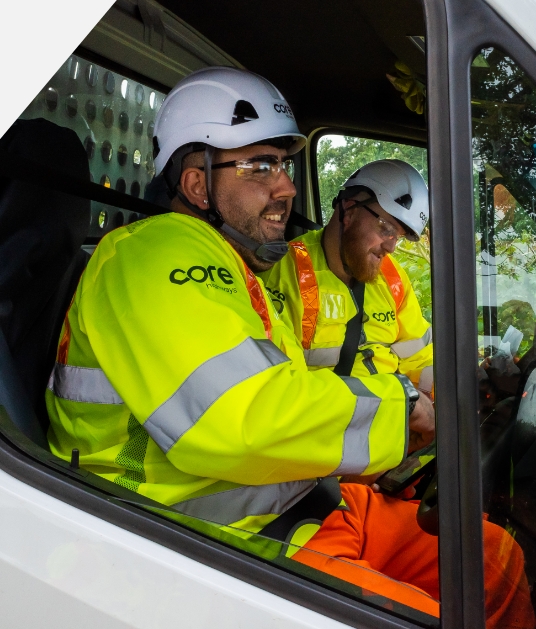As a business with sustainability
and the health of the environment
at its heart, Core Highways is continuously looking at ways it
can reduce its carbon footprint.
Reinforcing that approach is the Core Highway attitude towards idling, targeting unnecessary idling for the good of the planet.
Core Highway has rolled out idling guidelines with the specific aim of
reducing emissions – a vital step in its net zero target.
Why does Core Highways want to reduce idling?
Core Highways has a target of reaching net zero by the year 2040, so immediate steps in reducing it’s co2 emissions are crucial to hitting this goal. With carbon footprint coming under more intense scrutiny, Core Highways aims to showcase that it is a business committed to decarbonising its operations and remain a standout contender to deliver schemes nationwide
By eliminating unnecessary idling, Core Highways will reduce the number of ‘ghost miles’ that its vehicles produce. Ever 2 minutes idling produces 1 ghost mile, which has a knock-on effect for the life cycle and reliability of it’s fleet. Reduction in idling sees a reduction in fuel consumption and cost.In a bid to achieve its idling targets, the company has set out a 3-point action plan. The plan includes:
The 10-second rule
Unless in traffic, Core Highways advises all vehicles have the ignition turned off if idling for more than 10 seconds. The vehicle then stops producing harmful emissions, doesn’t put additional wear and tear onto vehicles – therefore extending life cycles – as well as preserving fuel.
Warming up
Vehicles warm up twice as quickly when being driven, as opposed to idling.
So, Core Highways is encouraging its workforce to remove time spent waiting for an engine to ‘warm up’ before driving. It takes no more than 30 seconds before a vehicle is sufficiently warm to be able to drive, so no more than half a minute should be spent ‘warming the engine up’.
"Core Highways has a target of reaching net zero by the year 2040."

Mindful Welfare
Whilst Core Highways knows there are times that its fleet must have engines running for welfare and powering ancillary items, the company sets out a mindful approach. A vehicle’s cab will remain warm for a period of time without the engine running for example, so the company is urging its workforce to be mindful throughout its operations and turn off those ignitions when not required.
Here are a few common idling myths that can be busted, in order to inspire others to turn their attention to unnecessary idling.
Myth: ‘The engine should be warmed up before driving.’
Fact: “Whilst not strictly untrue, idling is not an effective way to warm up an engine. Driving the vehicle is far more fruitful. With today’s modern engine, and the advent of electric engines, even the coldest winter days only require 30 seconds warming up via idling as an absolute maximum.”
Myth: ‘Idling is good for your engine.’
Fact: “Absolutely false. Excessive idling can damage engine components including cylinders, spark plugs and exhaust systems. An idling engine is not operating at peak temperature, which means fuel doesn’t undergo complete combustion. The residue this leaves can condense on cylinder walls where they can contaminate the oil and damage parts of the engine.”
Myth: ‘Turning off and restarting your vehicle is hard on the engine.’
Fact: “Again, false. Actually, restarting has little impact on engine components such as battery and starter motor.”
Myth: ‘Shutting the engine off and restarting uses more fuel than leaving the engine running.’
Fact: Again, very false. The bottom line is that anything over 10 seconds of idling uses more fuel than restarting your engine.”
So, there you have it. Myths busted. A plan in place, as well as hope that others in the sector will start paying extra attention to their idling vehicles as we all move towards a greener highways sector.
"10 seconds of idling uses more fuel than restarting your engine."
Core Highways Strengthens leadership team
View previous articleCore Highways invests £1m for 237 SRL portable traffic light systems
View next article
Let’s work
together
.jpg)

